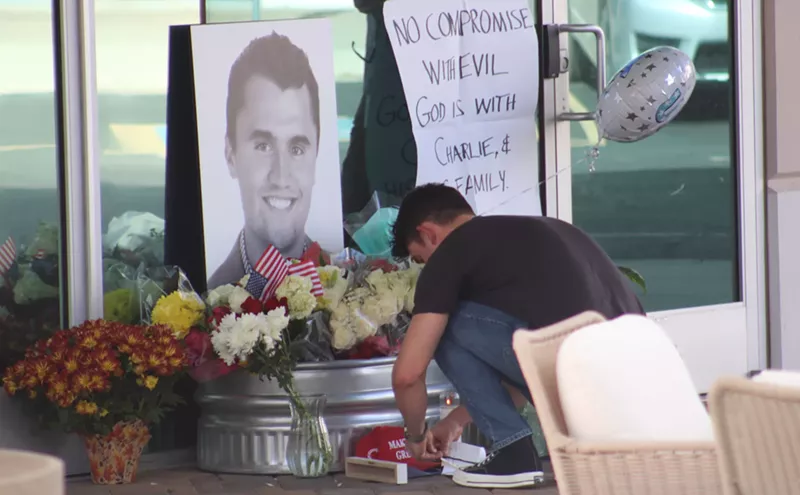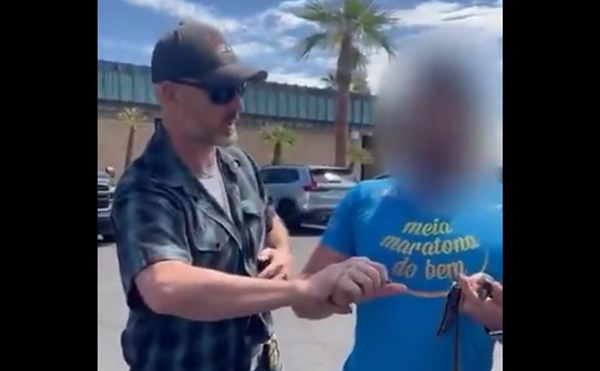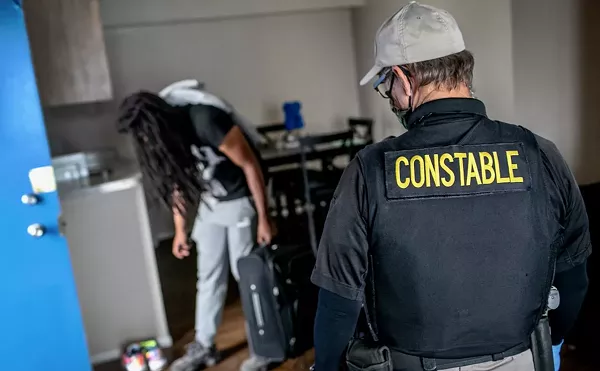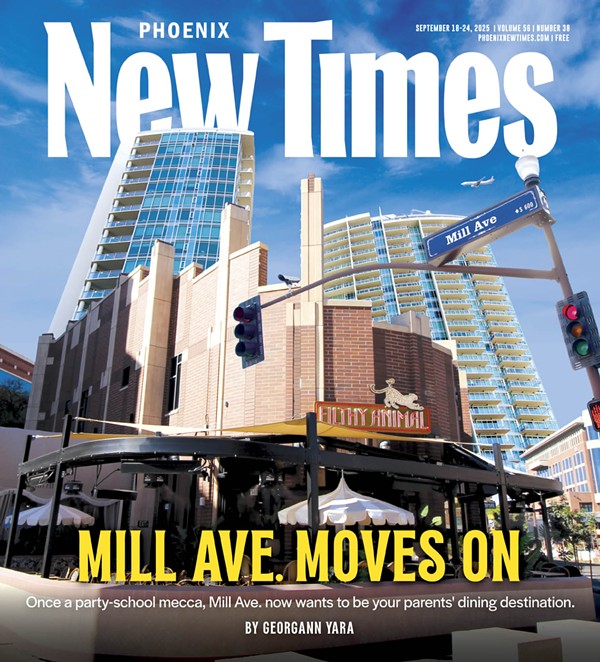Gloriously garish, even!
But no matter how you looked at it (and over the years, millions of motorists, many coming to and from Sky Harbor International Airport, did), the landmark motel at the intersection of 24th Street and Van Buren was perfectly Polynesian. How many other motels in town boasted tropical decor featuring gigantic tiki masks, twin torches that scorched the sky and a volcanic-rock fire fountain, not to mention a steeply thatched roof that looked like it was about to blast off into orbit at any moment?
But the luau's over for the Kon Tiki Hotel. Closed since October, this fabled hunk of hula heaven was recently sold to Verde Realty Advisers and is scheduled to be razed before the end of the year. Although there are no immediate plans for the property, a source at the company confides, "We're crossing our fingers and toes that someone leases it." Some "Aloha!"
@rule:
@body:Like Diamond Head shrouded in sea mist, the Kon Tiki Hotel's early years are fogged in a haze of secondhand information, fuzzy memories and quasi-truths, none of which can be readily substantiated today. Many of the principal characters involved with the motel during its heyday have died or disappeared. Of those whose whereabouts have been determined, very few seem to see any future in reminiscing over the past glories of what was once the Valley's best-known motel and what will soon be a vacant lot.
One exception is Mark Alexander, son of one of the original owners. Now a custom homebuilder in the Valley, Alexander explains that the motel was built by his father, Charles Alexander, in partnership with an uncle and the late Wayne L. Romney, a Valley-based motel magnate whose holdings also included Sundancer and Egyptian motels.
"When it first opened, the Kon Tiki was probably the nicest hotel in town," says Alexander. "Actually, it operated like a resort like you'd see out in Scottsdale. We'd get a lot of honeymooners. And in the winter, we always had a number of people from the Midwest who'd come and spend the entire season. And they were not a weekly rate, either; they were paying the regular daily rental.
"The restaurant was also very successful. On Mother's Day and holidays like that, we were doing the kind of business that you see now at the resorts."
On the threshold of teendom when the four-story, 111-room motel opened for business, Alexander recalls working as a busboy in the Kon Tiki's restaurant every summer during his youth. But just exactly what year the motel opened, no one seems to remember; estimates from former employees and others connected to the motel span the range from 1960 to 1964.
"I think I was about 11, so it had to have opened sometime during the early Sixties," claims Alexander, who vaguely pinpoints the motel's opening date as either 1962 or 1963. In any event, the first year the Kon Tiki appeared in the Phoenix telephone book or city directory was 1962.
"My father and his partners wanted to build something that would be a little bit different," says Mark Alexander. "They wanted something that would really catch the eye." Inspired by motels they'd seen in both the islands and San Diego, a city whose tropical-themed hostelries included a motel whose cocktail lounge featured an underwater mermaid revue behind the bar, the partners quickly realized that Polynesia was the stylistic wave of the future. They gave their architect the green light, wikkiwikki.
@rule:
@body:Some 30 years later, the Valley's most spectacular, if doomed, example of Polynesian pizzazz continues to fascinate architecture buffs.
"This wasn't the interpretive stuff of someone like Frank Lloyd Wright or some of the others who were interested in the abstract simplicity of Asian architecture," says Reed Kroloff, assistant director of Arizona State University's college of architecture. "This was outright stylistic grabbing. The guys who were doing places like the Kon Tiki were doing the Googie's of Asian architecture." (Googie's" refers to the look-at-me school of space-age coffee shop/bowling alley design popular in the mid-Fifties.)
"You've got the big, sweeping, skirtlike corners, similar to the kind of thing you might see in Asia or throughout the Pacific," Kroloff explains. "But in the Pacific, you won't see it stacked on top of what is essentially an American box motel. All they've really done at the Kon Tiki is taken a rectangular building and plopped a fantastic roof on it. This is schlock--but great schlock."
Another observer is equally enthusiastic, albeit more reserved, in her admiration for the motel. "The Kon Tiki is so representative of its time, 'where building is sign' and you've got the experience of creating an exotic place in the middle of a city," says Deborah Abele of the Phoenix Historic Preservation Office. "Of course, it was built in a time when economics weren't the driving force they are today, when one was allowed the luxury of spending a little extra to create character places. In fact, some of my commission members remember as kids how neat the Kon Tiki was and how they wanted to go there. There's definitely a sentiment there. This is a piece of Phoenix history."
@rule:
@body:Not surprisingly, there's still some confusion over exactly who designed the kitschy landmark. Mark Alexander credits Peter Lendrum, an architect still active in the Valley, and claims to remember seeing the architect on site during much of the motel's construction. But during a recent conversation, Lendrum insists he had absolutely nothing to do with the Kon Tiki and reports that the motel was actually designed by the late Ralph Haver, a Valley architect best remembered for his "modern" flat-topped homes of the Fifties. (City records indicate that a building permit was issued for the Kon Tiki in November 1961, but does not name the architect.)
Explaining that he's often been mistakenly linked to the Kon Tiki, Lendrum guesses that the confusion stems from the fact that he designed the Samoan Village Motor Hotel, a rival Hawaiian-themed hostelry built at 39th Street and Van Buren in 1964. Still standing but no longer in operation, Lendrum's long-neglected tiki huts now look disturbingly like a series of nuclear reactors.
"That Polynesian-village frou-frou stuff was big back in the early Sixties," says Lendrum. "Why was it so popular? I have no idea."
@rule:
@body:For the answer to that head-scratcher, pop sociologists need look no further than August 21, 1959, a date that will forever live in cultural infamy. That was the day Hawaii became the 50th state, an event that would change the country's landscape--or at least the northwest corner of 24th Street and Van Buren--for years to come.
Knowing little or nothing about the tropical paradise except what they'd seen in movies and travelogues, many Americans couldn't have been more thrilled if Disneyland's Enchanted Tiki Room attraction had been admitted to the Union. Almost overnight, Polynesia pervaded virtually every aspect of American life, from literature, movies and music to television, fashion, home entertaining, even housing.
Hawaii, James Michener's mammoth tome of 1960, dominated best-seller lists for nearly two years, eventually inspiring not one, but two motion pictures, the first arriving on screens in 1966. For those who couldn't wait, there was Elvis Presley's Blue Hawaii, Gidget Goes Hawaiian, and Diamond Head, a turgid pineapple opera starring Charlton Heston.
Hi-fis reverberated to the exotic, easy-listening sounds of Martin Denny and Yma Sumac; even former Mouseketeer Annette Funicello got into the act with her album Hawaiiannette featuring the hit tune "Pineapple Princess." On television, hula skirts and homicide provided the background for Hawaiian Eye, a popular, if improbable, detective series that ran from 1959 to 1963. Still hungry for luaus and larceny, audiences helped turn Hawaii Five-0 into a big hit five years later. And for the couch potato with less bloodthirsty taste, there was always Adventures in Paradise (1959-1962), a sort of seagoing Route 66 with a schooner replacing the Corvette. Suburban hostesses who had previously thought that "muumuus" were sounds made by cows suddenly began sporting those voluminous floral-print cotton smocks, the attire for any woman attending a backyard luau. And when she and her happy-shirted hubby arrived at the neighbors' tiki-torch-lined lawn, it was a cinch they'd sip mai tais and nibble culinary exotica like "Flaming Cabbage Head Weenies With Pu Pu Sauce." Culled from a women's magazine of the period, this actual recipe involved heating cocktail franks over a can of Sterno stuck in a hollowed-out head of cabbage.
And for mainland-bound Polyphiles who were seriously committed to this leisurely new way of island living, there were brand-new subdivisions and apartments that boasted of enclosed patios, tropical landscaping and Hawaiian-style trim on the windows and roofs. Witness this florid prose from a 1960 sales brochure touting a Polynesian-themed housing development in northwest Phoenix: "At Sands West, your family warrior can retire from his daily battle to your private lanai and find relaxation. . . . At Sands West, your work will be done as if by menehune [Hawaiian elf], thanks to the convenience of all-electric living. Your home is also protected from Kumumahanahana--God of Heat--by complete air conditioning and superior insulation."
@rule:
@body:While the high-visibility Kon Tiki was unquestionably the Big Kahuna of the Valley's Polynesian movement, the brochure quoted above proves that the fanciful motel certainly had no lock on the style. In fact, several commercial enterprises dating back as far as the mid-Fifties had experimented with faux tropicana. One of the earliest was the Bikini lounge at 15th Avenue and Grand, a small tiki bar in continuous operation for more than 40 years. Much more memorable are The Islands and Trader Vic's, two now-defunct Polynesian restaurants that opened several years before the Kon Tiki was built. For sheer architectural chutzpah, The Islands easily gave the Kon Tiki a run for its money, looking like the cover of a Martin Denny album come to life. Best described as resembling a ceremonial lodge house, the sprawling restaurant that once stood at 4839 North Seventh Street appeared to be constructed entirely out of bamboo and palm fronds. If that weren't enough, the building's exterior also featured a waterfall, a moat and numerous palm-tree trunks carved to resemble tiki masks. Trader Vic's in Scottsdale's Fifth Avenue District took a similar (if more restrained) approach, saving its big guns for the restaurant's interior. While the decor was pretty much standard issue for this type of place (catamarans, blowfish, fishing nets, lava lamps and other specious island artifacts were scattered throughout the hutlike building), first-time visitors rarely failed to gasp in awe as they slurped slushy rum drinks out of garishly decorated ceramic bowls only slightly smaller than a birdbath.
In the Valley, at least, the Hawaiian craze lasted well into the Sixties. As late as 1966, a small Polynesian-themed strip mall was built in the 6700 block of East McDowell Road. Although the development (which included such unlikely tenants as Norge Polynesian, the Valley's only Hawaiian-style laundromat) has since been razed to make way for a car dealership, a steep-roofed, tiki-themed Dairy Queen, long closed, has somehow escaped the wrecking ball.
@rule:
@body:The Kon Tiki should be so lucky.
Little more than a decade after the Kon Tiki opened for business, East Van Buren's motel row was already a far cry from the mecca of tidy tourist havens that it had been in 1962. Strapped for customers when the new interstate to the south drained tourist traffic from the street, many of Van Buren's small-time innkeepers fought for survival by transforming their motor courts into adult motels, complete with waterbeds, closed-circuit porn and mirrored ceilings. Although the Kon Tiki didn't realize it at the time, it was the beginning of the end.
"It was still great when I first went to work there," reports former night auditor Dale Hickox, a Kon Tiki employee since 1986, some nine years after the original owners had sold the motel to a San Francisco businessman. "We had a good clientele, people from all over the world and a lot of snowbirds who'd stay there until they could make more permanent arrangements." Sometime during this period, the motel also worked out a contract with AHCCCS, providing discount rooms for out-of-town patients from around the state who needed special medical attention available only in Phoenix. Hickox recalls a female cancer patient who spent an entire summer shuttling between the Kon Tiki and the nearby county hospital for treatment. "Sweetest girl you'd ever want to meet," says Hickox. "Every day she went through that damn radiation treatment and twice a week she'd have chemotherapy on top of it. It was heartbreaking."
By the late Eighties, the motel's clientele had grown even more diversified. Because of the Kon Tiki's proximity to several clubs, its plummeting room rates and, most important, its funky atmosphere, the fading Polynesian palace eventually developed a reputation as the place to stay for rock bands who were playing Phoenix. As a result, as once happened in 1988, it was possible to find a pair of winter visitors from the Midwest sunning themselves at one end of the pool, while at the other end, a musician from Great Britain chatted with a local journalist, recounting a profound LSD trip that had changed his life forever.
"I interviewed more bands in the Kon Tiki than I can remember," says Andy Van De Voorde, New Times' music editor during that era. "And with few exceptions, all of them commented on what a great place it was. I remember this one guy in particular--don't ask me from which band--who just couldn't get over the place--Hawaiian charm in the heart of Phoenix!'"
@rule:
@body:But by the late Eighties, the charm was wearing dangerously thin for the not-so-little grass shack on Van Buren. Engulfed in the tsunami of vice that had already swallowed much of that hardened artery, the once-swank motel's guest registry eventually began to resemble a police blotter.
"You have to give that place credit," says a former cab driver familiar with the neighborhood. "They held out for as long as they could. Up until a few years ago, it was a respectable place--or as respectable as you're going to find on Van Buren. But it finally got to the point that they had to take whatever business they could."
"One thing led to another, and the first thing you knew, we were renting rooms to drug dealers and hookers," Dale Hickox recalls. "Of course, we tried to keep em out, but if someone walked in there and he or she was dressed decently, we had no way of knowing what their occupation was until it was too late."
The dead giveaway that a guest was up to no good? An overloaded switchboard. "Some of these people were making more calls in one night than I make in six months," explains Hickox. "That was a pretty good indicator they were selling something--whether it was guns or drugs or pussy or what have you. And once word gets around to these kind of people, it was almost impossible to keep them out."
"Towards the end, all we were getting were people off the street," agrees Marsha Heberlein, the motel's manager for the last two years. "That neighborhood has gone into serious decline; now it's overrun with street people, drugs and prostitution. It finally became very difficult to fight that all the time."
Making matters worse, says Hickox, was the absentee owner's decision to sublease the motel's restaurant and cocktail lounge to a Valley promoter who used the facility to stage after-hours raves--not exactly the sort of activity to engender repeat business with whatever legitimate customers the motel still had.
"Before you knew it, we had 250 teenagers hanging out in the parking lot until four o'clock in the morning," fumes Hickox. "It was ridiculous. I could be within five feet of the telephone and that damn music was so loud I couldn't hear it ring." And on those rare occasions when he could, Hickox claims he was absolutely powerless to do anything about noise complaints because of the way the subleasing deal had been set up. "If a guest called to complain about the noise, we actually had to tell them to call the police," says Hickox. In spite of the fact that the landmark is now far more tacky than tiki, both Dale Hickox and Marsha Heberlein regret that the motel will soon be history.
"It's very sad," say Heberlein. "It is a landmark and I had hoped that someone would say, 'Please don't tear it down.' But the area is so bad that there's really nothing that can be done."
@rule:
@body:Although it's now a moot point, local historic preservationists reluctantly agree.
"Within the whole preservation movement, the concern over preserving the recent past is probably one of the thorniest issues," concedes Deborah Abele, who reports that Valley preservationists have repeatedly discussed the Kon Tiki's fate, even though the group is helpless to do anything.
"Unfortunately, the Kon Tiki is not even close to meeting the necessary criteria," she says, pointing out that to qualify for historic preservation, a building must meet "pages" of prerequisites.
If nothing else, Abele points out the Kon Tiki is simply not old enough; in order to even qualify for consideration, a building must be at least 50 years old. As a result, local preservationists fear that in a city as young as Phoenix, where entire blocks are routinely razed, there may one day be no architectural sign of the Sixties whatsoever. "The Kon Tiki certainly had kitsch value, there's no doubt about that," concedes Dave Wright, vice chairman of the historic preservation commission. "But as far as historic value, I don't think we've come to grips with that yet.
"The cycle between when something is built and when it's torn down and redeveloped has become so fast now that it's really hard to say that something is 'historic' after only 30 years. If we were to say, 'Here's this 1960s motel and it's historic,' I think a lot of people would think we had to be joking."
Still, Wright regrets seeing the Kon Tiki come tumbling down; he still has fond memories of once spending the night there with his family in the Sixties.
"As kids, we were just entranced by the place because it had the huts and the roof and everything--it was just really great," he recalls. "It's sad to see it come to such an ignoble end. But if you think about it, what has happened to the Kon Tiki is the story of what has happened to Van Buren, right there.












